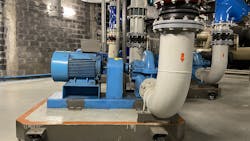NEC: Air Conditioning and Refrigerating Equipment — Part 5
Article 440, Part V provides the requirements for the motor controllers used in HVAC and refrigeration compressors. The text is dense, so let’s break it down.
Every motor-compressor controller must have two ratings [440.41(A)], and these are based on the compressor.
- Continuous-duty full-load current rating. Its value must be must be at least that of the nameplate-rated load current or the branch-circuit selection current (whichever is the greater of the two) of the compressor.
- Locked-rotor current rating. Its value must be at least that of the locked-rotor current of the compressor.
But what if the motor controller is rated in horsepower and doesn’t have one of these ratings? Then you must determine the equivalent currents from one of these tables:
- Equivalent full-load current rating, use Table 430.248, 249, or 250 as applicable. 248 applies to single-phase motors, 249 applies to two-phase motors, and 250 applies to three-phase motors.
- Locked-rotor current rating, use Table 430.251(A) or (B) as applicable. (A) applies to single-phase motors, use (B) for two- and three-phase motors of Design B, C, or D.
What if a controller serves more than one load? Then determine the combined load per 440.12(B). The number you come up with is the minimum vale for the continuous-duty full-load current rating and the locked-rotor current rating of that controller [440.41(B)].
The requirements for rating motor controllers not in hermetic motor circuits are in Article 430, Part VII. A key difference is instead of requiring the ratings to be at least as big as the compressor rating, Article 430 requires the rating to be at least as big as the motor rating.
About the Author

Mark Lamendola
Mark is an expert in maintenance management, having racked up an impressive track record during his time working in the field. He also has extensive knowledge of, and practical expertise with, the National Electrical Code (NEC). Through his consulting business, he provides articles and training materials on electrical topics, specializing in making difficult subjects easy to understand and focusing on the practical aspects of electrical work.
Prior to starting his own business, Mark served as the Technical Editor on EC&M for six years, worked three years in nuclear maintenance, six years as a contract project engineer/project manager, three years as a systems engineer, and three years in plant maintenance management.
Mark earned an AAS degree from Rock Valley College, a BSEET from Columbia Pacific University, and an MBA from Lake Erie College. He’s also completed several related certifications over the years and even was formerly licensed as a Master Electrician. He is a Senior Member of the IEEE and past Chairman of the Kansas City Chapters of both the IEEE and the IEEE Computer Society. Mark also served as the program director for, a board member of, and webmaster of, the Midwest Chapter of the 7x24 Exchange. He has also held memberships with the following organizations: NETA, NFPA, International Association of Webmasters, and Institute of Certified Professional Managers.
